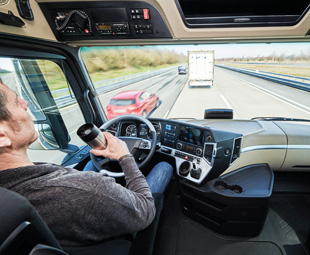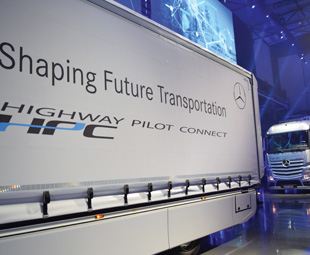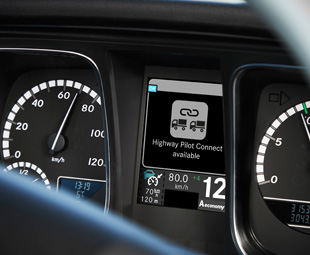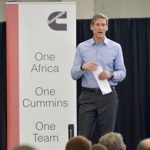Shaping future transportation

This is no idle heading to catch your attention – it was the theme for the Daimler Trucks 2016 Campus Connectivity event held in Düsseldorf, Germany. GAVIN MYERS made the trip and found that the company’s intent is undeniably serious.
Daimler does not think that its solutions alone will set the standard for all future transportation … This future is one that will bring together every sector of industry and each role player. After all, around the same time that this event took place the European Platooning Challenge was announced (see page 42). This will see numerous European truck brands linking their vehicles to drive in semi-autonomous convoy (dubbed platooning) across the continent.
While Platooning forms a great part of Daimler’s vision, the crux lies in the way it intends to integrate the system with the other evolving technologies in its arsenal, and with those in the rest of the supply chain network – creating a web of connectedness and communication for more-efficient vehicles and operations, as well as for safer roads.
“Transport volumes are not decreasing. Global road freight is expected to triple by 2050. One thing is clear: the road network will not triple. This is a huge challenge for everyone and everything involved with logistics,” explains Wolfgang Bernhard, member of the Board of Management of Daimler AG, responsible for Daimler Trucks & Buses.
 Daimler’s plans to meet this challenge by fully connecting the logistics network; thereby strengthening the flow of real-time information and reducing wasted resources. It is the connected truck that will provide this real-time information – becoming the main data node at the centre of the logistics network.
Daimler’s plans to meet this challenge by fully connecting the logistics network; thereby strengthening the flow of real-time information and reducing wasted resources. It is the connected truck that will provide this real-time information – becoming the main data node at the centre of the logistics network.
Connectivity has been an established part of the Daimler Trucks corporate strategy since 2013, and, in the next five years, the company will invest half a billion euro in the connection of its trucks, and in the creation of associated new services and digital solutions. The Digital Solutions and Services unit has, therefore, been created, which will be headed by Daniela Gerd Tom Markotten.
“We understand the potential of connectivity, and are determined to realise it,” Bernhard comments.
With the connected truck being at the centre of this vision, it is the perfect starting point from which to explore the idea. A modern Daimler truck features around 400 sensors, which generate valuable data about the vehicle and its environment.
“For efficient logistics real-time data is essential – and our trucks supply this data,” notes Bernhard. But what does one do with it? The first aspect is the Highway Pilot Connect system, Daimler’s semi-autonomous driving system that allows the vehicles to communicate with one another and platoon. (We covered the concept, known as vehicle-to-vehicle communication, in the cover story of the April edition.)
Here, connectivity ensures that all the vehicles respond immediately to unforeseen events, increasing safety; it allows them to close up to one another to reduce drag, resulting in a lowering of fuel consumption and emissions – up to seven percent average for all vehicles in the platoon; and it reduces the space taken up by a three-vehicle convoy from 150 to 80 m, creating more space on the road and shortening overtaking distances.
 All members of the platoon are kept informed about the driving situation of the entire platoon at all times.
All members of the platoon are kept informed about the driving situation of the entire platoon at all times.
In addition, by interacting with the infrastructure around it, vehicle-to-infrastructure communication allows the truck (or platoon) to pass on and receive data to and from others around it – including current speed limits, traffic-light phases, weather patterns and unforeseen events.
It is estimated that, in Europe, a truck spends only 35 percent of its time driving, while around 25 percent of all truck mileage is spent on empty journeys. On average, the sector generates only two to three percent profit per order. The data gathered by the trucks can, therefore, also be used to refine the logistics network; increasing efficiency throughout and reducing the amount of time a vehicle stands.
“Our trucks fully connect with their environment, becoming part of the internet. The truck connects all those involved: drivers, schedulers, fleet operators, workshops, manufacturers and insurance companies or authorities. They receive information in real time: about the condition of the tractor unit and semitrailer, traffic and weather conditions, the parking availability at rest areas and much more,” explains Bernhard.
“In the future it will be possible to reduce waiting times while loading and unloading, reduce paperwork and avoid traffic jams. With ‘flash’ updates over the air, or automated transfer of inbound time for trucks heading to the service point, maintenance time can be reduced significantly. It’s an enormous opportunity to intelligently cope with the growing volume of goods traffic, and to improve the performance of goods transport as a whole,” says Bernhard.
 Data security has been made a top priority, too: the customer has to decide whether, and for what purpose, their data can be used. Accordingly, Daimler attaches high data protection and data security – which is on par with the high standard used in banks – to developments in these new-technology areas,
Data security has been made a top priority, too: the customer has to decide whether, and for what purpose, their data can be used. Accordingly, Daimler attaches high data protection and data security – which is on par with the high standard used in banks – to developments in these new-technology areas,
Nothing can happen overnight, of course. One of the biggest challenges to the implementation of platooning is the need for a legislative and regulatory framework. The overall objective of all original equipment manufacturers and the Dutch government in the European Platooning Challenge is to jointly accelerate the introduction of a harmonised, cross-border regulation to optimise efficient road transport in the European Union.
Likewise, the future of connectivity relies on defined industry standards to allow the systems used by the multiple players to work in harmony.
Bernhard is positive. “If you ask me to blueprint the ultimate connected truck, I’d say: it will always be driving, it will always be fully loaded, it will never be stuck in a traffic jam, it will never fail – and it will be piloted by a happy driver. There will be no paperwork, no accidents and no breakdowns,” he smiles.
Prophetic words?
“OK, I’m well aware we might never completely get there – but it’s the direction we’re taking; at full speed and with a hot heart,” he adds.
More like serious intent.
Published by
Focus on Transport
focusmagsa




